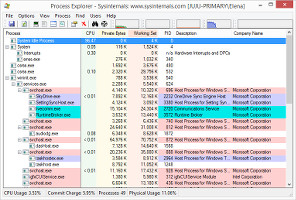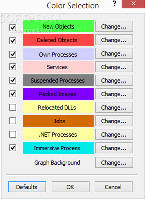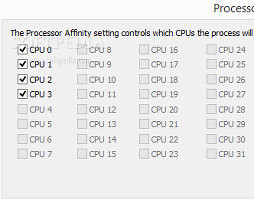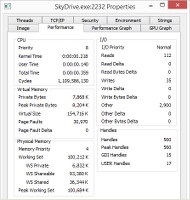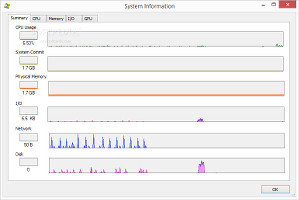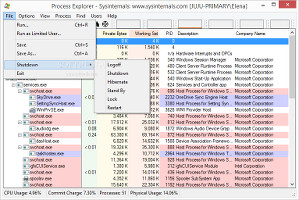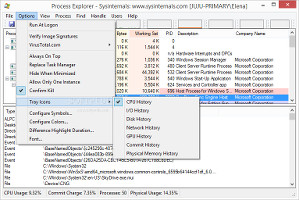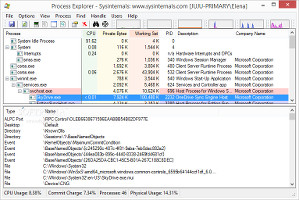Monitoring currently running processes gives us an idea about what Windows is doing in the background and helps us spot resource-demanding applications to either change their priority or affinity, suspend them, or just terminate the ones which are not responding to regular commands. Normally, this is Windows Task Manager's job, but most skilled users do not find it resourceful enough to meet their requirements.
Developed by Sysinternals (which has been acquired by Microsoft), Process Explorer has been around for a pretty long time and has thankfully remained free along the years. Wrapped up in feather-light and portable package, this advanced task manager gives users the possibility to keep track of active processes and tweak their settings, as well as to view extensive information about CPU and RAM usage, among other components. For instance, it is possible to discover all resources used by a process which keep users from launching other programs or removing files.
NOTE: Process Explorer 16.02 was tested on 64-bit Windows 8.1 Pro.
No installation required
Since there is no setup pack involved, the program files can be saved to any part of the hard disk in order to launch Process Explorer. It is also possible to make a copy and save the app to a removable storage unit, in order to run it on any PC without having to make any installations. Unlike most installers, the utility does not modify Windows registry settings or create extra files on the disk without permission, thus leaving no traces behind after its removal.
Classical and straightforward interface
Process Explorer is wrapped in a classical interface made from a regular window that populates a list with all active processes at startup in hierarchical view (all processes plus their derivatives). The program also integrates an icon in the system tray area that shows the live CPU usage when hovering the mouse over it (can be changed). By opening its right-click menu, it is possible to send an immediate power signal to the computer (e.g. shutdown, restart), bring up a panel to view system information, as well as to open and exit Process Explorer.
Tell processes apart by color and customize the colorsFor each active process, users may find out the CPU usage, private bytes, working set, process ID, description and company name. Holding the mouse cursor above an entry in the process list shows its command line and full path. Each line is highlighted in a different color to indicate new and deleted objects, the system's own processes, services, suspended processes, packed images, relocated DLLs, jobs, as well as .NET and immersive processes. These colors may be changed into something else (along with the graph background color) and reset to default.Control active processes and view extensive information
Users may specify which CPU cores a process may execute on by tweaking processor affinity settings, set priority levels (e.g. real-time, below normal, background, idle), terminate a process and its entire tree, suspend or restart it instead, bring it to the front, minimize, maximize or restore it, as well as create a small or full dump to find out its executions, loaded modules and other data.
Set the processor affinity and examine performance propertiesBringing up the properties panel of a process via the context menu shows advanced information such as base and dynamic priority, total cycles, user and kernel time, along with the start time and context switches, in addition to performance details and graphs, GPU graph, image and memory strings, and so on. Suspicious processes may be submitted to VirusTotal for malware scans using multiple av products at once.System info, other features and customization settings
From the View menu, it is possible to display a panel that reveals CPU, memory, I/O and GPU history in graphs, together with detailed information, such as total handles, threads and processes, total and available physical memory, as well as the current amount and limit of dedicated GPU memory. The first panel shows a summary on CPU, system commit, physical memory, I/O, network and disk history.
View system info and graphs, as well as explore the File menu for basic optionsCommand lines may be executed from the Windows Run function via the File menu while applying administrative rights or the credentials of another user. The list with all processes and their information may be saved to plain text documents, while the PC can be set to immediately log off, shut down, hibernate, stand by, lock, or restart.Moreover, Process Explorer can replace the Windows Task Manager, hide to the system tray area when minimized, and run at every system startup until further notice, while its window can be set to stay on top of other frames. Multiple program instances may be allowed, and the font type and size can be changed. Instead of showing CPU history, the tray icon can keep users up to date when it comes to real-time I/O, disk, network, GPU, commit or physical memory usage.
Explore the Options menu and show the lower pane with DLLs and handlesAdditionally, it is possible to display unnamed handles and mappings, a lower pane with DLLs or handles, as well as current user processes only, instead of everything. A search function is available for the list when it comes to tracking down specific DLLs and handles. The info update speed may be modified, while sets with different column arrangements can be saved, organized and loaded at a later time. If there are multiple sessions connected, users may disconnect, log off, remotely control the sessions, as well as send messages.The Good
All processes are color-coded by type, and these colors may be customized. It is possible to set affinities and priorities, kill, restart, suspend and resume processes, create dumps, submit files to VirusTotal for malware scans, as well as to view DLLs, handles and extensive system information and history with CPU, memory, I/O, GPU, disk and physical memory usage (graphs included). Any of these indicators may be shown in the notifications area for quick view.
The utility is portable and free to use.
The Bad
Process Explorer implements an option that allows users to quickly look up selected processes online by just clicking an entry from the context menu. However, there is a bug. Instead of searching for information using Google or other engine, it pastes the processor file name and extension in the address bar as if it were an actual web address (e.g. www.services.exe), which is obviously ineffective.
The Truth
In conclusion, this small, light and portable utility comes in handy to all power users who want to find out in-depth information about running processes and control their behavior, even if it's not the most attractive one out there.
Other similar system info, monitoring and tweaking applications include Process Hacker (free), Free Extended Task Manager (free), System Explorer (free), Process Lasso (not free) and Advanced Task Manager (not free).
NOTE: You can also read our previous review for Process Explorer 10.05.
 14 DAY TRIAL //
14 DAY TRIAL // 